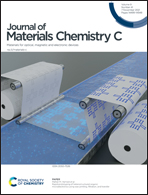Tuning the aggregation behaviour of BN-coronene diimides with imide substituents and their performance in devices (OLEDs and OFETs)†
Abstract
Compared to perylene diimides (PDIs), coronene diimides (CDIs), which can be viewed as a lateral core extension, show undesired effects for optoelectronic devices such as the decrease of the absorption and a hypsochromic shift. Here, we demonstrate that, if the core is extended with two BN units as opposed to two CC units, the opposite is true: large bathochromic shifts can be achieved, together with higher molar extinction coefficients and beneficial luminescence properties, e.g. small Stokes shifts and high quantum yields (Φlum > 94%). These effects can be explained by the influence of the BN-unit on the frontier molecular orbitals of the BNCDIs. Different substitution motifs at the imide position, cyclohexyl and 2,6-diisopropylphenyl, although they had no influence on the optical properties on a single molecule level, influenced the aggregation substantially so that the optical properties in the solid state and the performance in organic devices (OLEDs and OFETs) differed considerably. In combination with host matrices, devices with EQEs of up to 1.5% and white light emission (0.317; 0.346) were obtained. The developed synthetic route starting from a regioisomeric pure 1,7-substituted PDI leads to BNCDIs in good yields, which makes this class of compounds very promising.

- This article is part of the themed collection: 2021 Journal of Materials Chemistry C most popular articles


 Please wait while we load your content...
Please wait while we load your content...